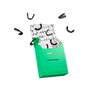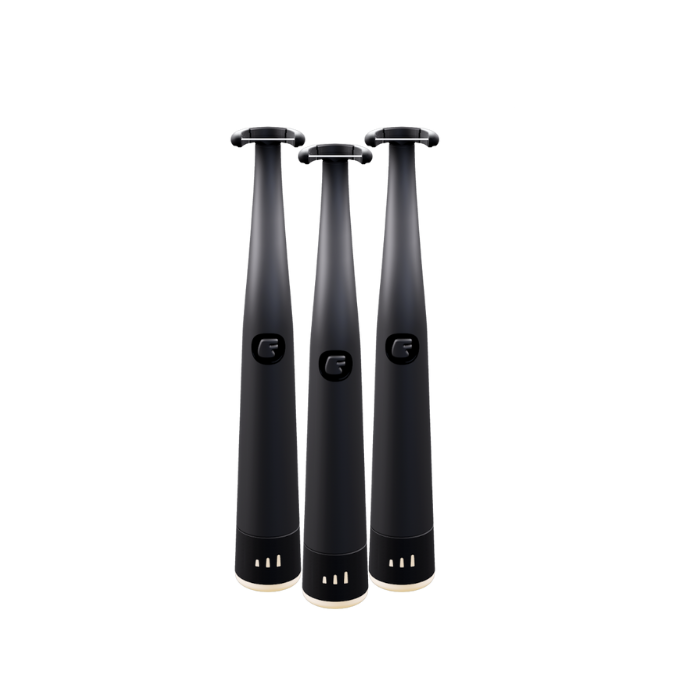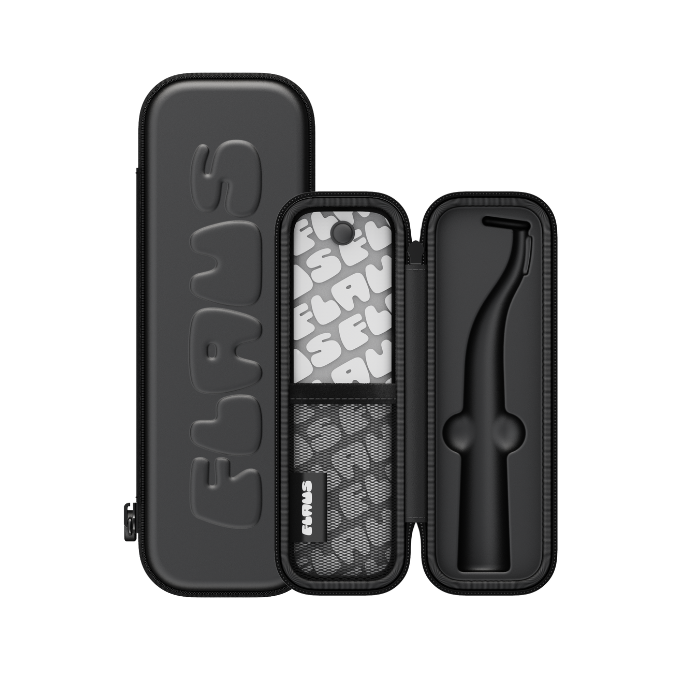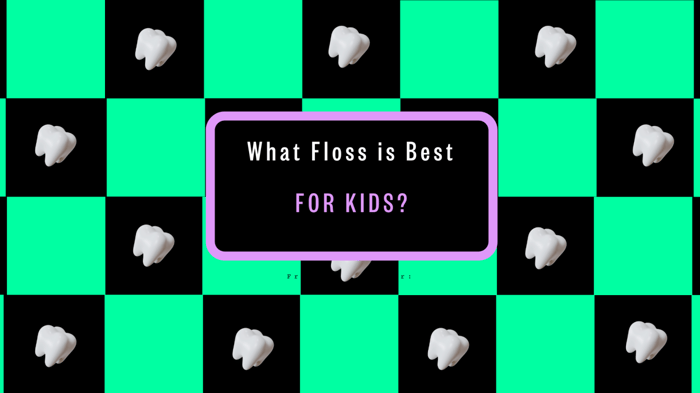Have you ever tried to get your kids to floss? It's difficult, time consuming and they come up with every excuse in the book as to why they can't stick their fingers in their mouth. But flossing children's teeth is so important! I'm sure you've looked for the he best floss for kids many times. We believe the best floss for kids is one that is comfortable to use and efficient at cleaning. But some other kid-approved floss traits include smooth texture, waxed floss (slides easily between teeth) and flavor! Who wouldn't love a taste of bubblegum or mint while caring for their teeth? Think smooth, sturdy, and yes, even tasty. Let's glide into this topic even further.
The best floss for kids is largely based on personal preference of the child. Whether it be waxed, flavored, un-flavored or an electric flosser - flossing children's teeth is incredibly important to their overall health.
Different Types of Floss for Kids: Waxed, Unwaxed, and Flavored
Kids' floss comes in various variations. Each type possesses unique qualities, which can significantly impact maintaining those tiny teeth clean. Let's delve into each kind so you can discover the best one for your child.
Waxed Floss
Waxed floss boasts a smooth texture that effortlessly glides between teeth. This can be particularly beneficial for kids who are just learning how to floss, as it's less likely to fray or tear. The smoothness simplifies maneuvering in small areas, aiding children in developing the habit of regular flossing without being deterred by rough texture or tearing.
Unwaxed Floss
In contrast, unwaxed floss is thinner and more pliable compared to its waxed counterpart. This allows it to fit into tighter spaces between teeth, making it an excellent option for children with closely set teeth or those with orthodontic braces. It's crucial to choose the right type of floss based on your child's specific dental needs to ensure effective cleaning and protection from cavities.
Flavored Floss
To make flossing a more enjoyable experience for kids, flavored floss is available in options such as mint, berry, bubblegum, etc. Attractive flavors can entice children to develop a positive association with flossing, turning it into a fun activity rather than a chore. This can significantly encourage consistent oral hygiene habits from an early age, setting the stage for a lifetime of good oral health.
By choosing the right type of floss for your child, you're not only promoting effective oral hygiene but also making their daily routine a more pleasant experience. It's all about creating healthy habits early on and ensuring that they continue throughout their lives. Regular dental check-ups should also include discussions about proper dental care at home, including selecting the best floss for your child's individual needs.
Understanding the distinct considerations that come into play when choosing the right floss for your child based on age and sensitivity is crucial. That knowledge will lay the groundwork for facilitating optimal oral hygiene practices in their formative years.
Choosing the Right Floss for Your Child: Age and Sensitivity Considerations
When it comes to encouraging children to floss, it's crucial to consider their age and sensitivity. Younger children are often more sensitive to strong tastes or textures, so providing them with flavored floss can make the experience more enjoyable and encourage them to make flossing a regular habit. On the other hand, older children have different dental needs and may benefit more from traditional waxed or unwaxed floss to effectively remove plaque and food debris.
It's important to recognize that a one-size-fits-all approach doesn't apply when it comes to flossing. Each child is unique and may require a different type of floss based on factors such as age, tooth spacing, and gum sensitivity. As a parent or guardian, understanding these considerations can help you make an informed decision about which type of floss is best suited for your child's oral hygiene routine.
Age Considerations
Younger kids typically have smaller mouths and developing motor skills, meaning they may struggle with traditional waxed or unwaxed floss. Introducing them to fun, flavored floss can turn what feels like a chore into a more pleasant experience.
For example, using strawberry or watermelon-flavored floss can make the process exciting for younger children, transforming it from a mundane task into something to look forward to. These fun flavors can capture their attention and make oral care seem less intimidating. On the other hand, as children grow older and become more adept at maneuvering the floss between their teeth, they can transition to using traditional waxed or unwaxed floss for more efficient cleaning.
Sensitivity Considerations
Children with sensitive gums require extra care when it comes to choosing the right type of floss. Waxed floss tends to be more gentle on sensitive gums as it slides more smoothly between teeth without causing irritation or discomfort. Furthermore, if your child has tight teeth or wears braces, unwaxed floss may be a better option as it can fit into closely spaced teeth or navigate around orthodontic brackets more effectively.
For instance, unwaxed floss glides easily between tightly packed teeth without shredding or getting stuck. This makes it ideal for older children who may have undergone orthodontic treatment or have teeth that are closely positioned.
By carefully considering your child's age and sensitivity levels, you can choose the most suitable type of floss that not only encourages regular dental hygiene practices but also promotes their overall oral health.
In helping our children cultivate effective oral hygiene habits through tailored choices in dental products, let's now shift our focus to examine some top brands of floss that are perfectly suited for kids.
Top Brands of Floss Suitable for Kids
When it comes to choosing the best floss for your kids, the array of available options can be overwhelming. From enthralling flavors and designs to ergonomic features tailored for children, several top brands offer exceptional floss products designed specifically for kids.
Flaus

Flaus, an electric flosser, is uniquely designed for people (and kids) who might not be so excited to floss. The unique design of Flaus allows flossing to be as easy, quick and comfortable as brushing your teeth!
Electric Flossers, like Flaus, use real dental floss and sonic vibrations to help make flossing quicker, easier and more comfortable! Flaus has a long, ergonomic handle that allows you to easily floss your teeth without having to put your fingers in your mouth like you would have to with traditional floss.
Flaus is easy to use and allows you to comfortably floss your back teeth and the sonic vibrations help you to get between those tight contact spaces. The vibrations also help to stimulate your gums (think a nice, relaxing massage for your gums) and help to disrupt the biofilm and plaque between your teeth.
This type of flosser is ideal for kids who may be use to an electric toothbrush and are looking to add flossing to their daily routine. It makes flossing easier, quicker and more hygienic (finger-free flossing). This product not only effectively cleans but also seeks to engage children in forming healthy dental habits from a young age.Floss Picks
A number of brands offer kid-friendly floss picks for our young family members. These floss picks do not have the same long, ergonomic handle as an electric flosser does, but they do help teach children how important flossing is (and help to establish a good dental hygiene routine).
Traditional String Floss
Traditional string floss is also great for kids. However, it does take some patience and teaching to get them to use it properly. Many floss brands will have fun colors and characters on their floss to help engage children in the important task of flossing.
Factors to Consider Before Buying Floss for Kids
Selecting the right floss for your children can elevate their dental routine, making it not just effective, but even enjoyable. Here are some key considerations before settling on the floss that best fits your child's needs.
Child's Preference
When deciding on the ideal floss for your child, it's crucial to consider their preferences. Certain flavors or textures might be off-putting to some children, so take their likes and dislikes into consideration. For example, while some kids might relish flavored floss, others may find it disagreeable. Involving them in the decision-making process by offering options and letting them make the choice can make the entire experience more agreeable.
Age-Appropriate Features
Children have unique requirements, extending to their oral care products as well. When selecting floss for kids, look for age-appropriate features such as thickness, ease of use, and engaging designs. Thicker floss might be simpler for small hands to grasp and maneuver, while vibrant or character-themed designs can inject an element of enjoyment into flossing. This can transform the entire process into a less daunting and more approachable activity for kids.
Additionally, consider the ease of use. Seek out flossers that are tailored for kids – they frequently come with handles that are easier to grip and operate (Flaus is a good example of this). The aim is to simplify the flossing experience to encourage consistent oral hygiene habits from an early age.
Dental Recommendations
Consulting a pediatric dentist can yield valuable insights when choosing the right floss for your child. A pediatric dentist can offer specific recommendations tailored to your child's oral health needs and any particular challenges they may encounter. They can provide guidance on whether traditional floss or flossers would be more fitting based on your child's age, coordination, and oral health condition.
For instance, if your child has braces or dental work, a pediatric dentist may suggest specialized dental floss threaders or orthodontic flossers to ensure thorough cleaning in hard-to-reach areas without causing damage or discomfort. This personalized recommendation ensures that you select the most suitable type of floss to support your child's oral hygiene routine.
By keeping these factors in mind, you'll be better equipped to choose the right floss for your child, aiding them in maintaining optimal oral health with a positive and enjoyable dental care experience.
At this point, you've learned about several vital considerations when choosing the best floss for your child. Now let's shift our focus to understand why instilling good flossing habits in children is crucial for their overall oral health.
Importance of Flossing for Children's Oral Health
Flossing is not just a task on the checklist; it's actually a superpower in the fight against cavities and gum disease. When kids eat, food particles get stuck between their teeth. If those particles aren't removed, they can turn into plaque, a sticky film of germs that sits on teeth, causing trouble by creating acids that can lead to cavities!
Regularly flossing your child's teeth will help remove these hidden plaque culprits, keeping their smile healthy and bright. It's like being a superhero defending your child's smile from annoying cavity villains!
Benefits of Flossing for Kids
-
Prevent Cavities and Gum Disease: Flossing every day ensures that those sneaky sugar bugs between the teeth don't stand a chance. Removing plaque buildup from these areas helps prevent cavities and reduces the risk of gum disease, which can lead to discomfort and even tooth loss if left unchecked.
-
Establish Good Oral Hygiene Habits: Fostering good dental hygiene habits early in life is like giving kids a secret weapon against future dental problems. Teaching them the importance of flossing equips them with valuable skills that they'll carry with them throughout their lives. Plus, it sets a positive example for other important concepts like overall hygiene and self-care.
- Remove Food Particles and Plaque Between Teeth: Not only does flossing keep them from having pesky cavities and hurting gums, but it also makes sure there are no uncomfortable bits of food stuck around in their mouths.
So, promoting this habit in your children isn't just about keeping their pearly whites looking pretty; it's also about setting them up for a lifetime of good oral health. Flossing may seem small in the grand scheme of things, but its impact is huge—it’s an essential part of their overall dental care routine.
Being aware of the significance of flossing for children is crucial for setting them up for long-term oral health. Now, let's leap forward and discuss effective methods for encouraging kids to floss regularly.
Tips on Encouraging Kids to Floss Regularly
Encouraging your kids to floss regularly might sound like a challenge, but there are ways to make it fun and less of a chore. Let's look at some effective strategies that can help you get your kids excited about flossing.
Lead by Example
Children often learn best by observing adults around them. So, one of the best ways to encourage your kids to floss is by leading the way yourself. When children see their parents or caregivers making flossing a regular part of their own oral care routine, it sets a positive example that can motivate them to do the same.
Flaus offers Family Bundles up to 40% off for the whole family - if you'd like to become a flossing family - this might be a great option for you.
Use Positive Reinforcement
Positive reinforcement is a powerful tool for shaping behaviors. Praise your kids for flossing regularly and make it a positive experience for them. Offer praise and encouragement when they take the initiative to floss on their own. This could be something as simple as acknowledging their efforts with a smile and words of encouragement.
By doing so, you reinforce the idea that flossing is a good thing and create positive associations with the activity in their minds.
Make it Fun
Kids love games and bright, colorful things. Utilize this fact to make the whole process of flossing more engaging. Consider using flossing games, stickers, or getting a colorful floss container to keep kids interested and entertained during their oral care routine.
For instance, making up a game where they aim for targets in between their teeth can turn what might seem like a tedious task into something exciting. Using flavored or colored floss may also make the experience more enjoyable for them.
Making these small adjustments in how you approach the topic can make a world of difference in how children view flossing. It's all about creating a positive environment and instilling good habits from an early age.
As we've explored strategies to encourage kids to form healthy oral habits, let's now shift our focus to a robust dentist-recommended routine that will ensure their dental health is set on the right track.
Dentist-Recommended Flossing Routine for Kids
Flossing is a crucial component of maintaining good oral hygiene, particularly for kids. As with all healthy habits, consistency is key. Similar to the recommendations for adults, children should aim to floss at least once a day, ideally before bedtime.
Establishing a consistent flossing routine early on sets the stage for a lifetime of healthy habits. Not only does it help remove food particles and plaque from between the teeth, but it also prevents the buildup of harmful bacteria that can lead to cavities and gum disease.
Consider making flossing part of the nightly routine, like brushing teeth before bed. This way, it becomes a natural habit, creating a sense of accountability and daily responsibility.
Moreover, when instructing kids to floss, it's important to emphasize gentle and careful flossing techniques. Kids should be encouraged to use a gentle sawing motion to avoid irritating their sensitive gums.
While it's true that kids may be prone to rushing through this process, remind them that taking their time and being gentle with the floss ensures thorough cleaning without causing discomfort or harm.
In addition, supervising young children during their flossing routine is crucial. It allows parents and guardians to ensure they are using the correct technique and reaching all areas between their teeth.
By instilling these simple practices from an early age, kids can develop lifelong dental care skills that will serve them well into adulthood.
Setting the stage for effective dental care from an early age provides a sturdy foundation upon which fun and engaging flossing routines for kids can thrive.
Ways To Make Flossing Fun and Easy For Kids
Getting your kids to floss can sometimes feel like pulling teeth—pun intended. However, making flossing a positive and enjoyable experience for children sets them on a path to a lifetime of good oral hygiene habits. Here are some fun and imaginative ways to encourage your little ones to embrace flossing as a regular part of their dental routine.
Fun Flossing Tools
While traditional dental floss may seem dull to kids, colorful or battery powered flossers can turn the chore of flossing into an entertaining activity. These child-friendly flossers not only make the process appealing to children but also help improve dexterity and coordination as they maneuver the floss between their teeth. By creating a positive association with colorful and fun designs, kids are more likely to view flossing as an engaging daily habit rather than a bothersome duty.
Playful Flossing Techniques
Encouraging children to engage their imagination can also contribute to making flossing enjoyable. You can prompt them to envision themselves as little "sugar bug sweepers" armed with their trusty flossers, heroically ridding their mouths of the pesky critters. Additionally, incorporating catchy songs or chants specifically dedicated to flossing time can add an element of fun and lightheartedness to the activity, effectively turning it into a playful event rather than a mundane task. The use of creative storytelling or rhythmic songs introduces an element of excitement into the otherwise routine act of flossing. It not only helps keep kids engaged while promoting good dental health practices but also fosters their creativity and storytelling skills.
Reward System
Implementing a reward system is another effective strategy for encouraging consistent flossing habits among children. By introducing a reward chart where children can earn incentives for regular flossing, such as stickers or tokens redeemable for a small toy or special treat, you create tangible motivation for them to adhere to their oral hygiene routine. This reward system not only instills responsibility early on but also allows kids to associate positive outcomes with performing daily oral care tasks. It ultimately transforms what could be seen as a tedious obligation into an exciting challenge with achievable rewards.
So here we have it—fun tools, imaginative techniques, and a rewarding system—all designed to make the process of flossing enjoyable and sustainable for children.
By making the process of flossing fun and enjoyable for kids, parents can ensure that their children develop healthy oral hygiene habits from an early age that will benefit them throughout their lives.
Are there any specific features or characteristics to look for in the best floss for kids?
Yes, there are specific features to look for in the best floss for kids. Firstly, the floss should be gentle on their sensitive gums yet effective in removing plaque and food debris.
Are there any additional tips or techniques for teaching kids how to floss properly?
Yes, there are additional tips and techniques for teaching kids how to floss properly. Parents can guide their kids through the process initially, demonstrating proper flossing techniques and emphasizing the importance of reaching all the tooth surfaces. According to a study published in the American Journal of Dentistry, parental involvement significantly improves children's ability to floss correctly.
How is children's dental health different from adults' dental health?
Children's dental health differs from adults' in several ways. Firstly, children have primary teeth, which are smaller and more prone to cavities. Studies show that nearly 60% of children aged 5-17 have experienced dental caries in their primary teeth. Additionally, kids are still developing their motor skills, making it challenging for them to brush and floss effectively. Statistics reveal that only 22% of children brush twice daily as recommended. Finally, with the consumption of sugary snacks and drinks on the rise among kids, their risk of tooth decay is elevated. Approximately 42% of children aged 2-11 have at least one cavity in their primary or permanent teeth. Therefore, it is crucial to prioritize proper oral hygiene practices and regular dental check-ups for children to maintain good dental health in their growing years.
What factors should be considered when choosing floss for kids?
When choosing floss for kids, several factors should be considered. Firstly, the floss should be gentle and soft to avoid irritating sensitive gums. Secondly, it should be easy to grip and maneuver, making it simpler for kids to use independently. A good example of this are electric flossers, like Flaus! Overall, prioritizing these factors will ensure that children maintain good oral hygiene habits early on.


















